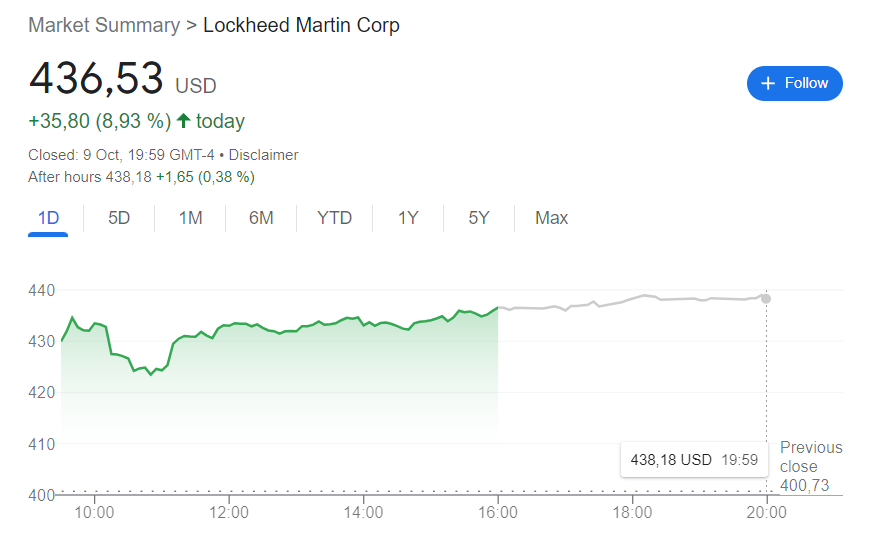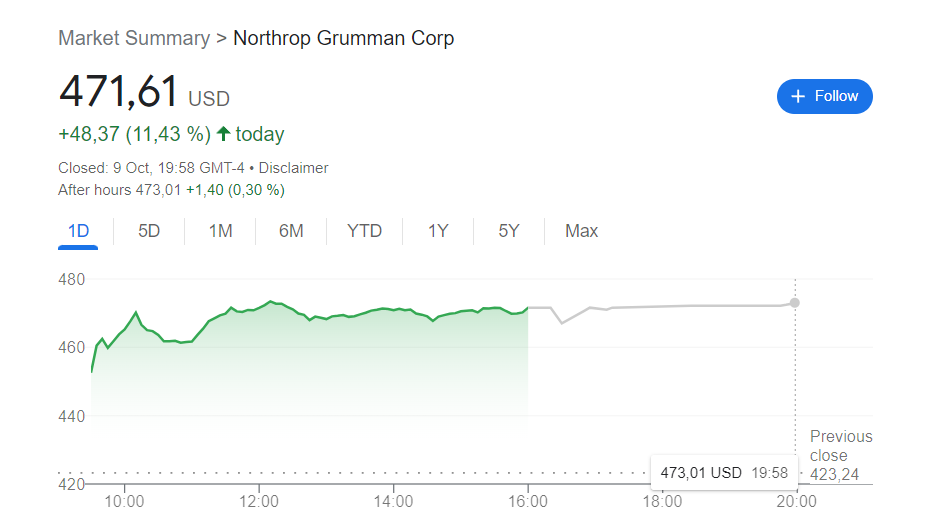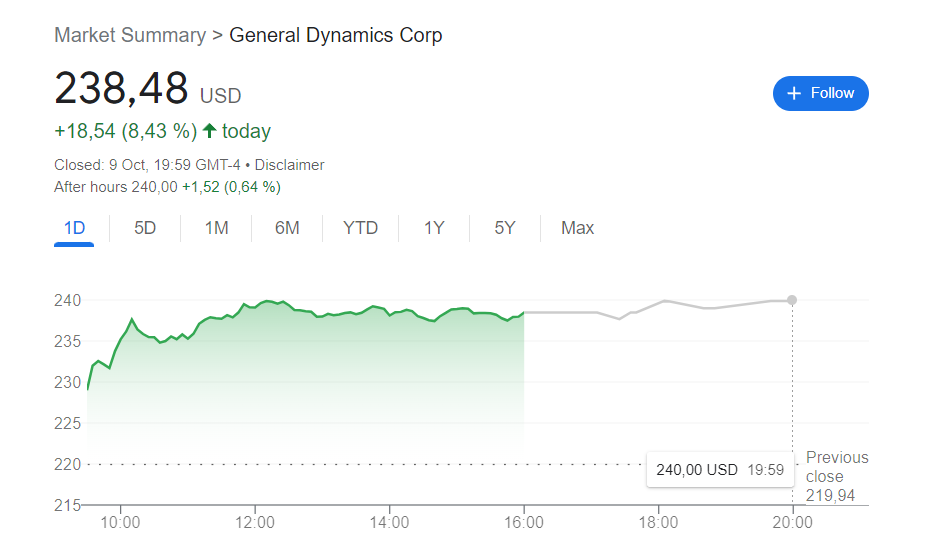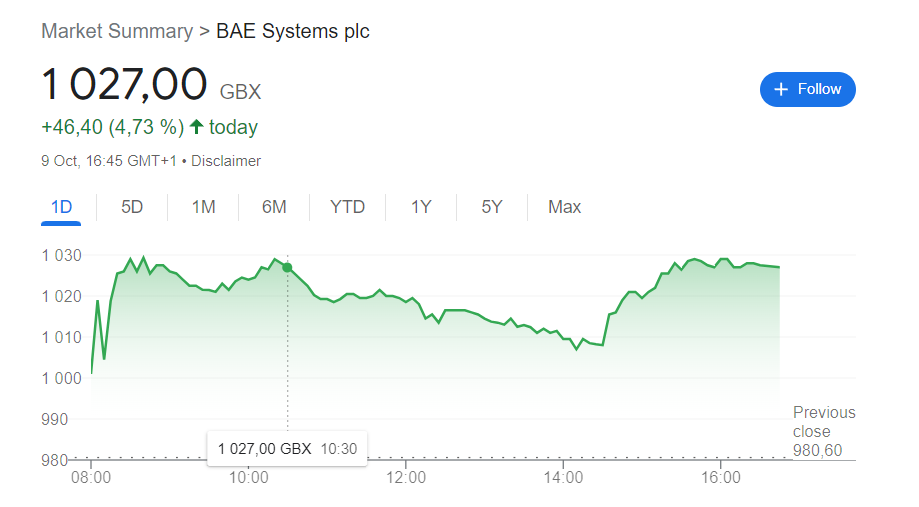Welcome to DU!
The truly grassroots left-of-center political community where regular people, not algorithms, drive the discussions and set the standards.
Join the community:
Create a free account
Support DU (and get rid of ads!):
Become a Star Member
Latest Breaking News
General Discussion
The DU Lounge
All Forums
Issue Forums
Culture Forums
Alliance Forums
Region Forums
Support Forums
Help & Search
Celerity
Celerity's Journal
Celerity's Journal
October 11, 2023

https://prospect.org/blogs-and-newsletters/tap/2023-10-11-bidens-latest-initiatives-junk-fees/

To take a tour of all the deceptive “junk fees” imposed on consumers by an array of industries is to appreciate the insidious nature of predatory capitalism that has become all too normal. Getting rid of junk fees and saving consumers hundreds of billions of dollars has been a Biden administration theme. It’s also very good politics, since it demonstrates how Democrats are on the side of ordinary people, as well as demonstrating the need for countervailing consumer regulation—and it smokes out Republican fake “populism,” since Republicans hate an activist state constraining corporate abuses. Today, the administration took junk-fee prohibition to a new level, with detailed initiatives by the Federal Trade Commission and the Consumer Financial Protection Bureau.
New FTC rules will require all businesses to show all fees up front, as well as clear disclosure of whether fees are refundable. This rule would apply to event tickets, hotels, car rentals, apartment rentals, and more. Companies that failed to comply would pay fines as well as customer refunds. New rules by the CFPB will require all banks to provide information requested by account holders free of charge. Another pending CFPB rule will make it easier for customers to send and receive data from banks and to switch banks. The CFPB announced research findings that its previous pro-consumer rules limiting bank fees on bounced checks have already saved consumers at least $2 billion.
All of these new rules are out for comment, and still need to be finalized, and we can expect a massive industry lobbying campaign to water them down. This kind of vivid pro-consumer activity is the Biden administration at its best, and it is frankly class warfare pitting the mass of citizens against rapacious and deceptive economic elites. Today’s announcement also enlisted the White House Office of Information and Regulatory Affairs (OIRA) to help mobilize other agencies of government to carry out the administration’s all-of-government competition agenda. In past administrations, Democrat as well as Republican, OIRA has been used mainly to bottle up or weaken regulations.
Last February, in a previous round of agency actions against junk fees, including limits on credit card late fees, Biden announced legislative plans for a comprehensive Junk Fee Prevention Act that would, among other things, ban early termination fees. Since then, much of what was proposed for legislation turns out to be within the power of the FTC, CFPB, the Department of Transportation, and other agencies under existing law. Still, it would be useful to get a floor vote on an anti–junk fee bill to put Republicans on the spot and give the issue added visibility. Such a bill was introduced in March by Sens. Blumenthal and Whitehouse, but has not come to the floor of either house. These orders are both a vivid demonstration of practical help to ordinary people, and a teaching tool about the need for creative and aggressive regulation against predatory opportunistic corporate deceptions.
snip
Biden's Latest Initiatives Against Junk Fees

https://prospect.org/blogs-and-newsletters/tap/2023-10-11-bidens-latest-initiatives-junk-fees/

To take a tour of all the deceptive “junk fees” imposed on consumers by an array of industries is to appreciate the insidious nature of predatory capitalism that has become all too normal. Getting rid of junk fees and saving consumers hundreds of billions of dollars has been a Biden administration theme. It’s also very good politics, since it demonstrates how Democrats are on the side of ordinary people, as well as demonstrating the need for countervailing consumer regulation—and it smokes out Republican fake “populism,” since Republicans hate an activist state constraining corporate abuses. Today, the administration took junk-fee prohibition to a new level, with detailed initiatives by the Federal Trade Commission and the Consumer Financial Protection Bureau.
New FTC rules will require all businesses to show all fees up front, as well as clear disclosure of whether fees are refundable. This rule would apply to event tickets, hotels, car rentals, apartment rentals, and more. Companies that failed to comply would pay fines as well as customer refunds. New rules by the CFPB will require all banks to provide information requested by account holders free of charge. Another pending CFPB rule will make it easier for customers to send and receive data from banks and to switch banks. The CFPB announced research findings that its previous pro-consumer rules limiting bank fees on bounced checks have already saved consumers at least $2 billion.
All of these new rules are out for comment, and still need to be finalized, and we can expect a massive industry lobbying campaign to water them down. This kind of vivid pro-consumer activity is the Biden administration at its best, and it is frankly class warfare pitting the mass of citizens against rapacious and deceptive economic elites. Today’s announcement also enlisted the White House Office of Information and Regulatory Affairs (OIRA) to help mobilize other agencies of government to carry out the administration’s all-of-government competition agenda. In past administrations, Democrat as well as Republican, OIRA has been used mainly to bottle up or weaken regulations.
Last February, in a previous round of agency actions against junk fees, including limits on credit card late fees, Biden announced legislative plans for a comprehensive Junk Fee Prevention Act that would, among other things, ban early termination fees. Since then, much of what was proposed for legislation turns out to be within the power of the FTC, CFPB, the Department of Transportation, and other agencies under existing law. Still, it would be useful to get a floor vote on an anti–junk fee bill to put Republicans on the spot and give the issue added visibility. Such a bill was introduced in March by Sens. Blumenthal and Whitehouse, but has not come to the floor of either house. These orders are both a vivid demonstration of practical help to ordinary people, and a teaching tool about the need for creative and aggressive regulation against predatory opportunistic corporate deceptions.
snip
October 11, 2023

https://prospect.org/world/2023-10-11-cooperative-that-could-s-group-finland/

HELSINKI – “The interesting thing about S Group is that it’s boring,” Evan Carr told me. We were standing in an S Market, a midsized grocery store chain, in the middle of downtown, near the train station. Sure enough, it was a completely unremarkable grocery store, somewhat fancier than Albertsons but less fancy than Whole Foods, with a large selection of all the usual foods, beverages, household goods, and so on. It was also packed with shoppers picking things up after the end of the working day. Carr, a tech worker who was born in America but has lived in Finland for more than 20 years, pointed to various labels on the shelves for vegetarian, vegan, or organic items. “You can request items and get them stocked,” he said. “I’ve done it myself.”

The interesting thing about S Market, and what brought me all the way to Finland, is not this bog-standard grocery store. It’s the parent entity S Group, a cooperative network owned by its members—and one of the biggest and most successful companies in Finland. S Group has about 2.5 million members—in a country of just 5.6 million inhabitants—representing 78 percent of Finnish households, along with 41,000 employees, 1,984 business locations, and an annual revenue of €13.5 billion last year. S Group accounts for fully 47 percent of the Finnish grocery market.

While nowhere near Walmart in absolute terms, relative to the size of the Finnish economy, it’s about twice as large as Walmart’s U.S. operations, which controls about a quarter of domestic grocery spending. And it’s member-owned. From an American perspective, this is difficult to understand. Practically our whole society is built on the assumption that the only way to have a wealthy, productive economy is for entrepreneurs to be incentivized with massive rewards for building efficient businesses. It is necessary for people like Jeff Bezos and Elon Musk to become rich beyond the dreams of avarice, so the theory goes, because otherwise we wouldn’t have Amazon or Tesla.

One might attack this narrative empirically—Amazon was helped tremendously in its early days by not paying state sales taxes, while Tesla has relied on large government subsidies for most of its existence—but S Group poses a more fundamental challenge. Here we have a hyper-efficient retail operation, run with cutting-edge management and logistics, dominating half the grocery market of a wealthy country, without minting a single billionaire in the process. It is not just competitive with capitalist businesses; it is more successful. It’s enough to make the ghost of Ronald Reagan cry.
How did it happen?.....................
snip

The Cooperative That Could: How S Group became Finland's most dominant retailer

https://prospect.org/world/2023-10-11-cooperative-that-could-s-group-finland/

HELSINKI – “The interesting thing about S Group is that it’s boring,” Evan Carr told me. We were standing in an S Market, a midsized grocery store chain, in the middle of downtown, near the train station. Sure enough, it was a completely unremarkable grocery store, somewhat fancier than Albertsons but less fancy than Whole Foods, with a large selection of all the usual foods, beverages, household goods, and so on. It was also packed with shoppers picking things up after the end of the working day. Carr, a tech worker who was born in America but has lived in Finland for more than 20 years, pointed to various labels on the shelves for vegetarian, vegan, or organic items. “You can request items and get them stocked,” he said. “I’ve done it myself.”

The interesting thing about S Market, and what brought me all the way to Finland, is not this bog-standard grocery store. It’s the parent entity S Group, a cooperative network owned by its members—and one of the biggest and most successful companies in Finland. S Group has about 2.5 million members—in a country of just 5.6 million inhabitants—representing 78 percent of Finnish households, along with 41,000 employees, 1,984 business locations, and an annual revenue of €13.5 billion last year. S Group accounts for fully 47 percent of the Finnish grocery market.

While nowhere near Walmart in absolute terms, relative to the size of the Finnish economy, it’s about twice as large as Walmart’s U.S. operations, which controls about a quarter of domestic grocery spending. And it’s member-owned. From an American perspective, this is difficult to understand. Practically our whole society is built on the assumption that the only way to have a wealthy, productive economy is for entrepreneurs to be incentivized with massive rewards for building efficient businesses. It is necessary for people like Jeff Bezos and Elon Musk to become rich beyond the dreams of avarice, so the theory goes, because otherwise we wouldn’t have Amazon or Tesla.

One might attack this narrative empirically—Amazon was helped tremendously in its early days by not paying state sales taxes, while Tesla has relied on large government subsidies for most of its existence—but S Group poses a more fundamental challenge. Here we have a hyper-efficient retail operation, run with cutting-edge management and logistics, dominating half the grocery market of a wealthy country, without minting a single billionaire in the process. It is not just competitive with capitalist businesses; it is more successful. It’s enough to make the ghost of Ronald Reagan cry.
How did it happen?.....................
snip

October 11, 2023

Dairy milk is cheaper at the counter—and your taxes keep it that way.
https://www.motherjones.com/food/2023/10/milking-it-plant-milk-starbucks-oat-soy-dairy-subsidy-climate/

Like an estimated two-thirds of the world’s population, I don’t digest lactose well, which makes the occasional latte an especially pricey proposition. So it was a pleasant surprise when, shortly after moving to San Francisco, I ordered a drink at Blue Bottle Coffee and didn’t have to ask—or pay extra—for a milk alternative. Since 2022, the once Oakland-based, now Nestlé-owned cafe chain has defaulted to oat milk, both to cut carbon emissions and because lots of its affluent-tending customers were already choosing it as their go-to.
Plant-based milks, a multibillion-dollar global market, aren’t just good for the lactose intolerant: They’re also better for the climate. Dairy cows belch a lot of methane, a greenhouse gas 25 times more potent than carbon dioxide; they contribute at least 7 percent of US methane output, the equivalent emissions of 10 million cars. Cattle need a lot of room to graze, too: Plant-based milks use about a tenth as much land to produce the same quantity of milk. And it takes almost a thousand gallons of water to manufacture a gallon of dairy milk—four times the water cost of alt-milk from oats or soy.
But if climate concerns push us toward the alt-milk aisle, dairy still has price on its side. Even though plant-based milks are generally much less resource-intensive, they’re often more expensive. Walk into any Starbucks, and you’ll likely pay around 70 cents extra for nondairy options. Dairy’s affordability edge, explains María Mascaraque, an analyst at market research firm Euromonitor International, relies on the industry’s ability to produce “at larger volumes, which drives down the cost per carton.”
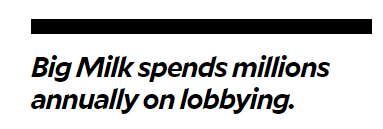
American demand for milk alternatives, though expected to grow by 10 percent a year through 2030, can’t beat those economies of scale. (Globally, alt-milks aren’t new on the scene—coconut milk is even mentioned in the Sanskrit epic Mahābhārata, which is thousands of years old.) What else contributes to cow milk’s dominance? Dairy farmers are “political favorites,” says Daniel Sumner, a University of California, Davis, agricultural economist. In addition to support like the “Dairy Checkoff,” a joint government-industry program to promote milk products (including the “Got Milk?” campaign), they’ve long raked in direct subsidies currently worth around $1 billion a year.
snip
Plant Milk Is Better for Us and the Climate. So Why Do We Subsidize Dairy?

Dairy milk is cheaper at the counter—and your taxes keep it that way.
https://www.motherjones.com/food/2023/10/milking-it-plant-milk-starbucks-oat-soy-dairy-subsidy-climate/

Like an estimated two-thirds of the world’s population, I don’t digest lactose well, which makes the occasional latte an especially pricey proposition. So it was a pleasant surprise when, shortly after moving to San Francisco, I ordered a drink at Blue Bottle Coffee and didn’t have to ask—or pay extra—for a milk alternative. Since 2022, the once Oakland-based, now Nestlé-owned cafe chain has defaulted to oat milk, both to cut carbon emissions and because lots of its affluent-tending customers were already choosing it as their go-to.
Plant-based milks, a multibillion-dollar global market, aren’t just good for the lactose intolerant: They’re also better for the climate. Dairy cows belch a lot of methane, a greenhouse gas 25 times more potent than carbon dioxide; they contribute at least 7 percent of US methane output, the equivalent emissions of 10 million cars. Cattle need a lot of room to graze, too: Plant-based milks use about a tenth as much land to produce the same quantity of milk. And it takes almost a thousand gallons of water to manufacture a gallon of dairy milk—four times the water cost of alt-milk from oats or soy.
But if climate concerns push us toward the alt-milk aisle, dairy still has price on its side. Even though plant-based milks are generally much less resource-intensive, they’re often more expensive. Walk into any Starbucks, and you’ll likely pay around 70 cents extra for nondairy options. Dairy’s affordability edge, explains María Mascaraque, an analyst at market research firm Euromonitor International, relies on the industry’s ability to produce “at larger volumes, which drives down the cost per carton.”

American demand for milk alternatives, though expected to grow by 10 percent a year through 2030, can’t beat those economies of scale. (Globally, alt-milks aren’t new on the scene—coconut milk is even mentioned in the Sanskrit epic Mahābhārata, which is thousands of years old.) What else contributes to cow milk’s dominance? Dairy farmers are “political favorites,” says Daniel Sumner, a University of California, Davis, agricultural economist. In addition to support like the “Dairy Checkoff,” a joint government-industry program to promote milk products (including the “Got Milk?” campaign), they’ve long raked in direct subsidies currently worth around $1 billion a year.
snip
October 10, 2023

Bad times are ahead. And we're not ready.
https://wisdomofcrowds.live/p/complacency-and-the-coming-storm

Watching events unfold this weekend in Israel, I thought back to a feeling that I first felt more than two months ahead of Russia launching its war in Ukraine. That same sense of dread is, if nothing, more firmly entrenched in my chest today. The feeling is still nebulous. It’s as if we are all watching a catastrophic car crash and simply don’t have the vocabulary to describe it. I’ll be impressionistic, and follow my stream of consciousness. “Autocracy versus democracy” does not usefully describe the moment. It feels like a discarded line from some kind of late-night brainstorming session. Its purpose was ostensibly to organize thinking — to name a threat and to allow for collective action. In the cold light of day, it reads like self-regard.
For the past ten months, Israelis marched on the streets decrying tyranny, seeing political overreach in a democratic society as an existential threat. Many in IDF and Mossad elite echelons threatened to quit should the executive move on certain judicial reforms. Yes, political street theater, and the attendant dramatic speech, is itself part and parcel of the democratic process. And deep beliefs about values are vital for a democracy to thrive and reform itself. But many woke up on Saturday to the palpable fear of a real threat. Towns and small cities overrun by well-organized militia. Scores of civilians shot dead. Hostages abducted. As I write this on Monday night, the IDF is still fighting battles in Israeli population centers. Soon enough, it will be waging a Stalingrad-like fight in Gaza, doling out horrific human costs in pursuit of retribution. And that’s if no other nasty surprises are looming. The prevailing consensus is that 9/11 is the correct historical parallel for Israel. If Hezbollah enters the fight in the coming days, the 1973 Yom Kippur War will be a more apt comparison.
https://twitter.com/whsieh/status/1711506829849583753
The buck stops with Bibi Netanyahu. This happened on his watch. He has been in power for a long time, with his calling card being “security for Israelis.” A reckoning will surely come. But complacency was a sin widely indulged in by most Israelis. I’ve only visited Israel once, in 2019. While I was there, Hamas was launching salvos of rockets into the south. In Tel Aviv and Jerusalem, it felt as if you were reading about some conflict time zones away. Iron Dome was doing its thing. Two people from our group drove south to watch the rocket trails at night from a bypass. As I noted at the time, Israelis were by and large resigned to the fact that they could manage all this, perhaps indefinitely. It wasn’t quite the technocratic triumphalism that has gripped the West’s imagination since 1989. But it was a related affliction.
No, it’s not about democracy versus autocracy. The wheels are coming off. Our predecessors bequeathed to us a period of unprecedented tranquility. They were not infinitely wise in getting us here — no wiser than we are. But we grew up used to it in ways they could never imagine. We assumed order was normality, that peace was what naturally arose when power-hungry hyperpowers minded their own business. A better and more just world was there for the taking, if only we were moral enough to push for it. The overarching metaphor in one of Robert Kagan’s recent books is fundamentally correct: order is a garden to be tended, but the jungle is the norm. I still hold that his moralistic “authoritarianism versus democracy” paradigm is misguided. Morality has nothing to do with it. Pessimism about progress — a conviction that nothing is permanent — is a far better guide.
snip
Complacency and the Coming Storm

Bad times are ahead. And we're not ready.
https://wisdomofcrowds.live/p/complacency-and-the-coming-storm

Watching events unfold this weekend in Israel, I thought back to a feeling that I first felt more than two months ahead of Russia launching its war in Ukraine. That same sense of dread is, if nothing, more firmly entrenched in my chest today. The feeling is still nebulous. It’s as if we are all watching a catastrophic car crash and simply don’t have the vocabulary to describe it. I’ll be impressionistic, and follow my stream of consciousness. “Autocracy versus democracy” does not usefully describe the moment. It feels like a discarded line from some kind of late-night brainstorming session. Its purpose was ostensibly to organize thinking — to name a threat and to allow for collective action. In the cold light of day, it reads like self-regard.
For the past ten months, Israelis marched on the streets decrying tyranny, seeing political overreach in a democratic society as an existential threat. Many in IDF and Mossad elite echelons threatened to quit should the executive move on certain judicial reforms. Yes, political street theater, and the attendant dramatic speech, is itself part and parcel of the democratic process. And deep beliefs about values are vital for a democracy to thrive and reform itself. But many woke up on Saturday to the palpable fear of a real threat. Towns and small cities overrun by well-organized militia. Scores of civilians shot dead. Hostages abducted. As I write this on Monday night, the IDF is still fighting battles in Israeli population centers. Soon enough, it will be waging a Stalingrad-like fight in Gaza, doling out horrific human costs in pursuit of retribution. And that’s if no other nasty surprises are looming. The prevailing consensus is that 9/11 is the correct historical parallel for Israel. If Hezbollah enters the fight in the coming days, the 1973 Yom Kippur War will be a more apt comparison.
https://twitter.com/whsieh/status/1711506829849583753
The buck stops with Bibi Netanyahu. This happened on his watch. He has been in power for a long time, with his calling card being “security for Israelis.” A reckoning will surely come. But complacency was a sin widely indulged in by most Israelis. I’ve only visited Israel once, in 2019. While I was there, Hamas was launching salvos of rockets into the south. In Tel Aviv and Jerusalem, it felt as if you were reading about some conflict time zones away. Iron Dome was doing its thing. Two people from our group drove south to watch the rocket trails at night from a bypass. As I noted at the time, Israelis were by and large resigned to the fact that they could manage all this, perhaps indefinitely. It wasn’t quite the technocratic triumphalism that has gripped the West’s imagination since 1989. But it was a related affliction.
No, it’s not about democracy versus autocracy. The wheels are coming off. Our predecessors bequeathed to us a period of unprecedented tranquility. They were not infinitely wise in getting us here — no wiser than we are. But we grew up used to it in ways they could never imagine. We assumed order was normality, that peace was what naturally arose when power-hungry hyperpowers minded their own business. A better and more just world was there for the taking, if only we were moral enough to push for it. The overarching metaphor in one of Robert Kagan’s recent books is fundamentally correct: order is a garden to be tended, but the jungle is the norm. I still hold that his moralistic “authoritarianism versus democracy” paradigm is misguided. Morality has nothing to do with it. Pessimism about progress — a conviction that nothing is permanent — is a far better guide.
snip
October 10, 2023

Failing to moderate content such as fake news could incur fine of 6% of X revenues or EU blackout under new laws
https://www.theguardian.com/technology/2023/oct/10/eu-warns-elon-musk-over-disinformation-about-hamas-attack-on-x

The EU has issued a warning to Elon Musk over the alleged disinformation about the Hamas attack on Israel, including fake news and “repurposed old images”, on X, which was formerly known as Twitter.
The letter arrives less than two months after sweeping new laws regulating content on social media seen in the EU came into force under the Digital Services Act. If Musk, the owner of X, does not comply he can face a fine of 6% of his revenues from X or a total blackout in the EU.
Thierry Breton, the commissioner responsible for the act, wrote to Musk to urge him to ensure “a prompt, accurate, and complete response” to the request to contact Europol, the EU police enforcement agency, and “relevant law enforcement agencies” within the next 24 hours.
Breton reminded Musk that he needed to have “proportionate and effective mitigation measures to tackle the risks to public security and civic discourse stemming from disinformation”.
snip
https://assets.documentcloud.org/documents/24025072/european-commissions-letter-to-elon-musk.pdf


EU warns Elon Musk over 'disinformation' on X about Hamas attack

Failing to moderate content such as fake news could incur fine of 6% of X revenues or EU blackout under new laws
https://www.theguardian.com/technology/2023/oct/10/eu-warns-elon-musk-over-disinformation-about-hamas-attack-on-x

The EU has issued a warning to Elon Musk over the alleged disinformation about the Hamas attack on Israel, including fake news and “repurposed old images”, on X, which was formerly known as Twitter.
The letter arrives less than two months after sweeping new laws regulating content on social media seen in the EU came into force under the Digital Services Act. If Musk, the owner of X, does not comply he can face a fine of 6% of his revenues from X or a total blackout in the EU.
Thierry Breton, the commissioner responsible for the act, wrote to Musk to urge him to ensure “a prompt, accurate, and complete response” to the request to contact Europol, the EU police enforcement agency, and “relevant law enforcement agencies” within the next 24 hours.
Breton reminded Musk that he needed to have “proportionate and effective mitigation measures to tackle the risks to public security and civic discourse stemming from disinformation”.
snip
https://assets.documentcloud.org/documents/24025072/european-commissions-letter-to-elon-musk.pdf


October 10, 2023


Snøhetta has completed an addition to a Norwegian-American museum and folk art school in Iowa, which includes a large wooden oculus and a mass-timber frame. Vesterheim, the National Norwegian-American Museum and Folk Art School, explores the Norwegian-American immigration experience through folk and fine ar in Decorah, Iowa. Snøhetta created an 8,000 square feet (743 square metres) building for the museum, as well as adjoining outdoor spaces that connect the museum's Heritage Park to the street. "As an American-Norwegian company, Snøhetta is grateful and excited to play a part in recontextualizing the experiences, art, and crafts of Norwegian immigrants here in the United States since the 1820s," said Snøhetta founding partner Craig Dykers.

"The Commons and Heritage Park will create new opportunities for considering and understanding the experience of all immigrants to the United States, and contribute to the vitality of Decorah and the driftless region." Called the Vesterheim Commons, the building spans three floors and contains flexible event space, galleries, offices, a photography production studio and an outdoor terrace.

It also contains an interior connection to the neighbouring Folk Art School, which hosts classes in rosemaling, knifemaking, woodworking, and weaving. The new building's first floor has floor-to-ceiling windows and is topped with a wooden canopy that extends over the street, while the upper floors were clad in grey brick.

The project includes the addition of a gallery and office building, as well as the further development of the museum's outdoor greenspace. The studio created the canopy's soaring form based on traditional Norwegian boat design. A glass volume that spans the two upper floors was inserted off-centre, facing the street.
snip

Snohetta includes wooden oculus for Norwegian-American museum extension in Iowa
https://www.dezeen.com/2023/10/06/snohetta-extenstion-norwegian-american-museum-in-iowa/

Snøhetta has completed an addition to a Norwegian-American museum and folk art school in Iowa, which includes a large wooden oculus and a mass-timber frame. Vesterheim, the National Norwegian-American Museum and Folk Art School, explores the Norwegian-American immigration experience through folk and fine ar in Decorah, Iowa. Snøhetta created an 8,000 square feet (743 square metres) building for the museum, as well as adjoining outdoor spaces that connect the museum's Heritage Park to the street. "As an American-Norwegian company, Snøhetta is grateful and excited to play a part in recontextualizing the experiences, art, and crafts of Norwegian immigrants here in the United States since the 1820s," said Snøhetta founding partner Craig Dykers.

"The Commons and Heritage Park will create new opportunities for considering and understanding the experience of all immigrants to the United States, and contribute to the vitality of Decorah and the driftless region." Called the Vesterheim Commons, the building spans three floors and contains flexible event space, galleries, offices, a photography production studio and an outdoor terrace.

It also contains an interior connection to the neighbouring Folk Art School, which hosts classes in rosemaling, knifemaking, woodworking, and weaving. The new building's first floor has floor-to-ceiling windows and is topped with a wooden canopy that extends over the street, while the upper floors were clad in grey brick.

The project includes the addition of a gallery and office building, as well as the further development of the museum's outdoor greenspace. The studio created the canopy's soaring form based on traditional Norwegian boat design. A glass volume that spans the two upper floors was inserted off-centre, facing the street.
snip

October 10, 2023


The diversity of nature informed the latest exhibition at London's Kew Gardens, which features a garden designed to "break the binary" and a "deeply queer" textile pattern by designer Adam Nathaniel Furman. Queer Nature, which is on show inside the botanical garden's Victorian glasshouse Temperate House, is comprised of four different installations.


At the centre of the building, American artist Jeffrey Gibson presented his largest UK commission to date, called House of Spirits, which was hung from the glass ceiling and designed to catch the light. The colourful fabric features botanical illustrations as well as writing informed by "Gibson's own perspectives on queerness and nature", according to Kew.

Gibson drew on New York's ballroom scene as well as the work and life of artist and gay rights activist Derek Jarman when creating the installation. In an adjacent room, garden designer Patrick Featherstone installed Breaking the Binary, a temporary garden display created together with the Kew Youth Forum.

The installation saw the designer change the layout of the room to accommodate curving flowerbeds, in which he planted a collection of species that reproduce in ways that challenge the traditional way of categorising plants as male and female. "There's lots of variety in the way that plants reproduce and their gender is also quite complicated," Featherstone told Dezeen. "So if nature is going to be used in this human metaphor, then it's worth scrutinising further and seeing the diversity there is."
snip


Kew Gardens exhibition showcases Queer Nature in Victorian glasshouse
https://www.dezeen.com/2023/10/06/kew-gardens-queer-nature-victorian-glasshouse-exhibition/

The diversity of nature informed the latest exhibition at London's Kew Gardens, which features a garden designed to "break the binary" and a "deeply queer" textile pattern by designer Adam Nathaniel Furman. Queer Nature, which is on show inside the botanical garden's Victorian glasshouse Temperate House, is comprised of four different installations.


At the centre of the building, American artist Jeffrey Gibson presented his largest UK commission to date, called House of Spirits, which was hung from the glass ceiling and designed to catch the light. The colourful fabric features botanical illustrations as well as writing informed by "Gibson's own perspectives on queerness and nature", according to Kew.

Gibson drew on New York's ballroom scene as well as the work and life of artist and gay rights activist Derek Jarman when creating the installation. In an adjacent room, garden designer Patrick Featherstone installed Breaking the Binary, a temporary garden display created together with the Kew Youth Forum.

The installation saw the designer change the layout of the room to accommodate curving flowerbeds, in which he planted a collection of species that reproduce in ways that challenge the traditional way of categorising plants as male and female. "There's lots of variety in the way that plants reproduce and their gender is also quite complicated," Featherstone told Dezeen. "So if nature is going to be used in this human metaphor, then it's worth scrutinising further and seeing the diversity there is."
snip


October 9, 2023
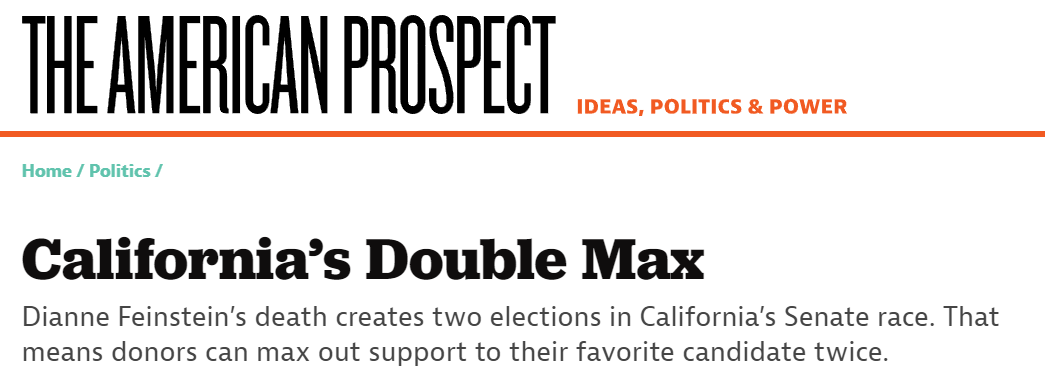
https://prospect.org/politics/2023-10-09-californias-double-max-senate-race/

Because of an obscure quirk in California election laws, the death of Dianne Feinstein is a gift to big-money interests trying to get their preferred candidate into the U.S. Senate. They can now double the amount they give to an individual campaign. Feinstein’s death on September 29 led to Gov. Gavin Newsom naming a replacement, former EMILY’s List president Laphonza Butler. But Butler will only serve until Election Day 2024. Under state law, a special election must be held to serve out the remainder of Feinstein’s term, from Election Day until the new session of Congress on January 3, 2025. That special election will appear on the same ballot as the regularly scheduled election for a six-year term for the seat.
This is a replay of what happened last year in California, when Alex Padilla replaced Kamala Harris as she ascended to the vice presidency. There were two primary elections on the ballot and two general elections. Padilla only had token competition, so it had no bearing on the outcome. The special election saw a drop-off of about 72,000 votes (out of 10.8 million cast) from the regular election; more Democratic voters dropped off than Republicans. Padilla won his six-year term with 61.1 percent of the vote, and won the two-month special election with 60.9 percent of the vote.
Today, Feinstein’s seat is being fiercely contested by three House Democrats, and potentially by Butler herself. All these candidates can choose to appear on the ballot twice. This raises some potential for misunderstandings from California’s famously disengaged electorate. “Californians don’t wake up in the morning thinking about politics,” said Darry Sragow, a longtime campaign operative in the state. “There’s a huge amount of confusion surrounding the double ballot. It’s not fair to voters.” But the far bigger impact is on campaign finance. Because there are two primaries and two general elections, candidates can receive a maximum donation for each race. Under the normal rules, the max donation would be $6,600: $3,300 for the primary and the same for the general. Now, candidates can receive up to $13,200 from an individual to their own campaign, if they appear on the ballot in both races.

Even some longtime political experts in the state were surprised by the implications. “Why is it a special election?” asked Bill Carrick, who has worked for multiple statewide elected officials in California, including Dianne Feinstein. “Talk about a head-scratcher.” Already, the Senate race was trending toward being the most expensive ever, due to running in a nation-state with nearly 22 million registered voters and several high-cost media markets. Now, candidates can call their most generous donors and tell them they can double their money, increasing the amounts in their campaign war chests. In general, this will grant the most benefit to the candidate who has received the most money from maxed-out donors: Rep. Adam Schiff. According to Politico, Schiff can receive an additional $3.2 million from the 495 donors who have maxed out to his campaign as of June; Rep. Katie Porter, who uses more of a small-donor strategy, has only 47 maxed-out donors, meaning the maximum benefit to her campaign would be about $310,000.
snip
California's Double Max: Dianne Feinstein's death creates two elections in California's Senate race.

https://prospect.org/politics/2023-10-09-californias-double-max-senate-race/

Because of an obscure quirk in California election laws, the death of Dianne Feinstein is a gift to big-money interests trying to get their preferred candidate into the U.S. Senate. They can now double the amount they give to an individual campaign. Feinstein’s death on September 29 led to Gov. Gavin Newsom naming a replacement, former EMILY’s List president Laphonza Butler. But Butler will only serve until Election Day 2024. Under state law, a special election must be held to serve out the remainder of Feinstein’s term, from Election Day until the new session of Congress on January 3, 2025. That special election will appear on the same ballot as the regularly scheduled election for a six-year term for the seat.
This is a replay of what happened last year in California, when Alex Padilla replaced Kamala Harris as she ascended to the vice presidency. There were two primary elections on the ballot and two general elections. Padilla only had token competition, so it had no bearing on the outcome. The special election saw a drop-off of about 72,000 votes (out of 10.8 million cast) from the regular election; more Democratic voters dropped off than Republicans. Padilla won his six-year term with 61.1 percent of the vote, and won the two-month special election with 60.9 percent of the vote.
Today, Feinstein’s seat is being fiercely contested by three House Democrats, and potentially by Butler herself. All these candidates can choose to appear on the ballot twice. This raises some potential for misunderstandings from California’s famously disengaged electorate. “Californians don’t wake up in the morning thinking about politics,” said Darry Sragow, a longtime campaign operative in the state. “There’s a huge amount of confusion surrounding the double ballot. It’s not fair to voters.” But the far bigger impact is on campaign finance. Because there are two primaries and two general elections, candidates can receive a maximum donation for each race. Under the normal rules, the max donation would be $6,600: $3,300 for the primary and the same for the general. Now, candidates can receive up to $13,200 from an individual to their own campaign, if they appear on the ballot in both races.

Even some longtime political experts in the state were surprised by the implications. “Why is it a special election?” asked Bill Carrick, who has worked for multiple statewide elected officials in California, including Dianne Feinstein. “Talk about a head-scratcher.” Already, the Senate race was trending toward being the most expensive ever, due to running in a nation-state with nearly 22 million registered voters and several high-cost media markets. Now, candidates can call their most generous donors and tell them they can double their money, increasing the amounts in their campaign war chests. In general, this will grant the most benefit to the candidate who has received the most money from maxed-out donors: Rep. Adam Schiff. According to Politico, Schiff can receive an additional $3.2 million from the 495 donors who have maxed out to his campaign as of June; Rep. Katie Porter, who uses more of a small-donor strategy, has only 47 maxed-out donors, meaning the maximum benefit to her campaign would be about $310,000.
snip
October 9, 2023
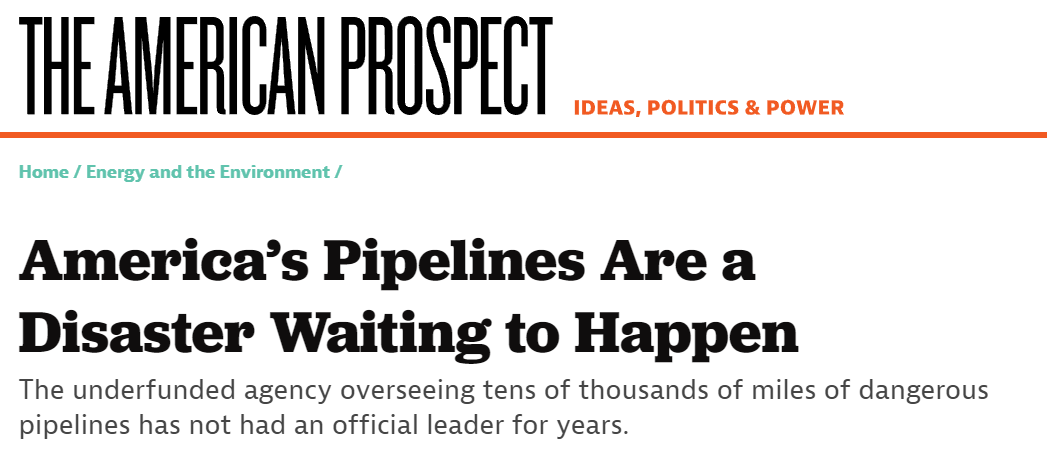
https://prospect.org/environment/2023-10-09-americas-pipelines-disaster-waiting-to-happen/

The American pipeline system is going gangbusters. In addition to the enormous network of oil and gas pipelines that cobwebs the nation, thousands of miles of new liquefied natural gas (LNG), hydrogen, and carbon capture pipelines have been proposed. If the Biden administration has its way, many of those proposals will be built expediently. Many have objections to these pipelines on climate or environmental protection grounds. But everyone agrees that whatever pipelines are built should at least be safe. That makes it quite bizarre that more than halfway through his term, President Biden still has yet to nominate an administrator to lead the Pipeline and Hazardous Materials Safety Administration (PHMSA) within the Department of Transportation. As my colleague Dylan wrote in April, in the aftermath of the Norfolk Southern train derailment, PHMSA played an indispensable role in keeping Americans safe from toxic materials.
The agency, though small, is responsible for regulating pipelines and overseeing transportation of many dangerous materials throughout the country, including flammable fuels, radioactive substances, and chemicals. Yet the top post at the agency has been vacant now for years. The current leader of PHMSA, Tristan Brown, has served as deputy administrator of the agency since 2021. His lack of permanence, owing to the fact that he isn’t an appointed and confirmed director, doesn’t help PHMSA to meet the rising challenge of additional pipelines. Research has shown it’s hard for the temporary acting leader of an agency, who can be likened to a substitute teacher, to enact change and turn an agency around, given their impermanence. As running PHMSA becomes an increasingly difficult job, the need for more official, stable, and permanent leadership is necessary to meet the challenge of the position.
The magnitude of issues and regulatory and enforcement gaps exceed the resources that the agency has. Staff capacity at PHMSA, which regularly sends out inspectors and engineers to do pipeline examinations, is particularly important. But staff numbers are low and haven’t increased significantly since 2016, despite the agency’s responsibilities seeing massive increases of both scope and consequence as pipeline proposals and constructions have risen drastically over the past decade. The agency simply doesn’t have the workforce to maintain enforcement at the needed level. Instead, it’s taken to reimbursing states for examinations of pipelines through a grant program. PHMSA is especially relevant in the aftermath of the Inflation Reduction Act, which created the conditions for a rapid build-out of two pipeline-dependent industries: carbon capture and storage, and hydrogen.

The Biden administration has been all in on carbon capture and storage, pushing for additional funding and fielding several proposals for carbon pipeline and storage facility build-out. One of the awardees for this funding is BP, which has planned several pipeline projects across the U.S. The proposals for massive new networks of CO2 pipelines for transporting captured carbon to sites for sequestration present new threats to local communities and the environment. CO2 is toxic at high concentrations, can travel large distances after a pipeline rupture, and pipelines carrying it are particularly susceptible to fractures. In 2020, for instance, one pipeline ruptured in Mississippi. Months after the rupture, residents of Satartia, Mississippi, still reported mental fogginess, lung and stomach issues, and fatigue.
snip
America's Pipelines Are a Disaster Waiting to Happen

https://prospect.org/environment/2023-10-09-americas-pipelines-disaster-waiting-to-happen/

The American pipeline system is going gangbusters. In addition to the enormous network of oil and gas pipelines that cobwebs the nation, thousands of miles of new liquefied natural gas (LNG), hydrogen, and carbon capture pipelines have been proposed. If the Biden administration has its way, many of those proposals will be built expediently. Many have objections to these pipelines on climate or environmental protection grounds. But everyone agrees that whatever pipelines are built should at least be safe. That makes it quite bizarre that more than halfway through his term, President Biden still has yet to nominate an administrator to lead the Pipeline and Hazardous Materials Safety Administration (PHMSA) within the Department of Transportation. As my colleague Dylan wrote in April, in the aftermath of the Norfolk Southern train derailment, PHMSA played an indispensable role in keeping Americans safe from toxic materials.
The agency, though small, is responsible for regulating pipelines and overseeing transportation of many dangerous materials throughout the country, including flammable fuels, radioactive substances, and chemicals. Yet the top post at the agency has been vacant now for years. The current leader of PHMSA, Tristan Brown, has served as deputy administrator of the agency since 2021. His lack of permanence, owing to the fact that he isn’t an appointed and confirmed director, doesn’t help PHMSA to meet the rising challenge of additional pipelines. Research has shown it’s hard for the temporary acting leader of an agency, who can be likened to a substitute teacher, to enact change and turn an agency around, given their impermanence. As running PHMSA becomes an increasingly difficult job, the need for more official, stable, and permanent leadership is necessary to meet the challenge of the position.
The magnitude of issues and regulatory and enforcement gaps exceed the resources that the agency has. Staff capacity at PHMSA, which regularly sends out inspectors and engineers to do pipeline examinations, is particularly important. But staff numbers are low and haven’t increased significantly since 2016, despite the agency’s responsibilities seeing massive increases of both scope and consequence as pipeline proposals and constructions have risen drastically over the past decade. The agency simply doesn’t have the workforce to maintain enforcement at the needed level. Instead, it’s taken to reimbursing states for examinations of pipelines through a grant program. PHMSA is especially relevant in the aftermath of the Inflation Reduction Act, which created the conditions for a rapid build-out of two pipeline-dependent industries: carbon capture and storage, and hydrogen.

The Biden administration has been all in on carbon capture and storage, pushing for additional funding and fielding several proposals for carbon pipeline and storage facility build-out. One of the awardees for this funding is BP, which has planned several pipeline projects across the U.S. The proposals for massive new networks of CO2 pipelines for transporting captured carbon to sites for sequestration present new threats to local communities and the environment. CO2 is toxic at high concentrations, can travel large distances after a pipeline rupture, and pipelines carrying it are particularly susceptible to fractures. In 2020, for instance, one pipeline ruptured in Mississippi. Months after the rupture, residents of Satartia, Mississippi, still reported mental fogginess, lung and stomach issues, and fatigue.
snip
Profile Information
Gender: FemaleHometown: London
Home country: US/UK/Sweden
Current location: Stockholm, Sweden
Member since: Sun Jul 1, 2018, 07:25 PM
Number of posts: 43,585
